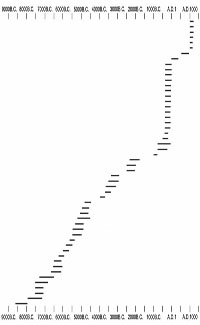Dating
More radiocarbon dates have come from Hinds Cave than any other archeological site in the Lower Pecos Canyonlands. A total of 55 reported radiocarbon assays have been run on samples from known or purported Hinds Cave materials. At least 12 other assays have been run on Hinds coprolites as part of the ongoing research of Hendrick Poinar, Kristin Sobolik, Vaughn Bryant, and others, but these additional assays have not yet been reported.
On the right is a graphical depiction of the 55 Hinds Cave radiocarbon dates now available (minus one clearly erroneous date rejected as implausibly old). As can be seen, the assays form an almost unbroken span stretching back before 8,000 B.C. to about A.D. 1200, a span of about 9,000 years. There are, however, four apparent gaps or thin spots representing periods of hundreds of years with few or no dates. This, of course, does not necessarily mean the site was not used by prehistoric peoples during those periods. These could simply be sampling gaps. Nonetheless, the gaps are roughly 4300-3900 B.C., 2500-2800 B.C., 1700-1000 B.C. (the most substantial gap), and a thin spot represented by only one assay falls between A.D. 400-1000.
Let’s briefly consider what these “dates” really represent. Radiocarbon assays are statistical estimates that yield approximate time range estimates, not precise dates. They are reported in radiocarbon years before the present (B.P. or RCYBP), corrected to account for known carbon fluctuation values, and then calibrated by reference to much more precise tree-ring chronologies. The calibrated values give an approximation of the estimated age in conventional calendar years B.C./A.D. Calibration yields an estimated midpoint within a statistical range often expressed as a “2 sigma” range, meaning that the true age of the dated sample has a 95% chance of falling within the range. In the accompanying graphics, the bars for each date depict the 2-sigma range, a span usually covering several hundred years. Throughout the Hinds exhibit the cited dates are usually expressed as calibrated midpoints, out of convenience and simplicity.
In practical terms, a single radiocarbon date does not give researchers a great deal of confidence that the one date accurately represents the “targeted event” – the activity that left behind the organic material dated. There are various factors that can cause erroneous estimates such as sample contamination, lab processing errors, and so on. That is why archeologists try to obtain suites or sets of dates from several different materials and different contexts (layers and excavation areas within sites) to gain confidence and detect meaningful patterns in the use of a site through time.
With these factors in mind, let's return to a discussion of the Hinds Cave radiocarbon record. Periods of time with multiple overlapping dates give us confidence that these were periods during which the shelter was occupied. But those major occupation periods we can be most confident about are those represented by dates from multiple samples representing different kinds of materials, different deposits and different areas of the site. On this basis, the samples from Analysis Units 7 and 5 seem clearly to mark major occupation periods at Hinds Cave, 7500-5600 B.C. and 5000-3000 B.C., respectively.
The dates from Analysis Units 5 and 6 overlap between about 4800-5300 B.C., suggesting the burned rock midden deposit designated Analysis Unit 6 formed at about the same time as the earliest deposits designated Analysis Unit 5. Keep in mind that the Analysis Units are stratigraphic zones rather than occupation periods, as explained in the Analysis Unit section.
While there are also many dates that fall into Analysis Unit 1 and 2, most of these (a total of 21 assays) were run on multiple samples from an infant bundle burial and nearby wooden sticks, which are purported to be from Hinds Cave. These materials are said to have been removed by an artifact collector from Hinds Cave in the 1950s. They were the subject of a special dating project recently reported by Steelman and others (2004). Given the lack of documentation, the provenience of these assays must be regarded as uncertain; the items could have been removed from another shelter in the area. Nonetheless, the dates fit within the projected age of the later deposits at Hinds Cave.
Serious students of archeology may want to study the radiocarbon assay details. These are provided as a downloadable pdf file.



